AutoCAD 2013
AutoLISP Developer's Guide
January 2012
�
© 2012 Autodesk, Inc. All Rights Reserved. Except as otherwise permitted by Autodesk, Inc., this publication, or parts thereof, may not
be reproduced in any form, by any method, for any purpose.
Certain materials included in this publication are reprinted with the permission of the copyright holder.
Trademarks
The following are registered trademarks or trademarks of Autodesk, Inc., and/or its subsidiaries and/or affiliates in the USA and other countries:
123D, 3ds Max, Algor, Alias, Alias (swirl design/logo), AliasStudio, ATC, AUGI, AutoCAD, AutoCAD Learning Assistance, AutoCAD LT, AutoCAD
Simulator, AutoCAD SQL Extension, AutoCAD SQL Interface, Autodesk, Autodesk Homestyler, Autodesk Intent, Autodesk Inventor, Autodesk
MapGuide, Autodesk Streamline, AutoLISP, AutoSketch, AutoSnap, AutoTrack, Backburner, Backdraft, Beast, Beast (design/logo) Built with
ObjectARX (design/logo), Burn, Buzzsaw, CAiCE, CFdesign, Civil 3D, Cleaner, Cleaner Central, ClearScale, Colour Warper, Combustion,
Communication Specification, Constructware, Content Explorer, Creative Bridge, Dancing Baby (image), DesignCenter, Design Doctor, Designer's
Toolkit, DesignKids, DesignProf, DesignServer, DesignStudio, Design Web Format, Discreet, DWF, DWG, DWG (design/logo), DWG Extreme,
DWG TrueConvert, DWG TrueView, DWFX, DXF, Ecotect, Evolver, Exposure, Extending the Design Team, Face Robot, FBX, Fempro, Fire, Flame,
Flare, Flint, FMDesktop, Freewheel, GDX Driver, Green Building Studio, Heads-up Design, Heidi, Homestyler, HumanIK, IDEA Server, i-drop,
Illuminate Labs AB (design/logo), ImageModeler, iMOUT, Incinerator, Inferno, Instructables, Instructables (stylized robot design/logo),Inventor,
Inventor LT, Kynapse, Kynogon, LandXplorer, LiquidLight, LiquidLight (design/logo), Lustre, MatchMover, Maya, Mechanical Desktop, Moldflow,
Moldflow Plastics Advisers, Moldflow Plastics Insight, Moldflow Plastics Xpert, Moondust, MotionBuilder, Movimento, MPA, MPA (design/logo),
MPI, MPI (design/logo), MPX, MPX (design/logo), Mudbox, Multi-Master Editing, Navisworks, ObjectARX, ObjectDBX, Opticore, Pipeplus, Pixlr,
Pixlr-o-matic, PolarSnap, PortfolioWall, Powered with Autodesk Technology, Productstream, ProMaterials, RasterDWG, RealDWG, Real-time
Roto, Recognize, Render Queue, Retimer, Reveal, Revit, RiverCAD, Robot, Scaleform, Scaleform GFx, Showcase, Show Me, ShowMotion,
SketchBook, Smoke, Softimage, Softimage|XSI (design/logo), Sparks, SteeringWheels, Stitcher, Stone, StormNET, Tinkerbox, ToolClip, Topobase,
Toxik, TrustedDWG, U-Vis, ViewCube, Visual, Visual LISP, Voice Reality, Volo, Vtour, WaterNetworks, Wire, Wiretap, WiretapCentral, XSI.
All other brand names, product names or trademarks belong to their respective holders.
Disclaimer
THIS PUBLICATION AND THE INFORMATION CONTAINED HEREIN IS MADE AVAILABLE BY AUTODESK, INC. "AS IS." AUTODESK, INC. DISCLAIMS
ALL WARRANTIES, EITHER EXPRESS OR IMPLIED, INCLUDING BUT NOT LIMITED TO ANY IMPLIED WARRANTIES OF MERCHANTABILITY OR
FITNESS FOR A PARTICULAR PURPOSE REGARDING THESE MATERIALS.
�
Contents
Chapter 1
Chapter 2
Introduction . . . . . . . . . . . . . . . . . . . . . . . . . . . . 1
Introduction . . . . . . . . . . . . . . . . . . . . . . . . . . . . . . . . 1
AutoLISP . . . . . . . . . . . . . . . . . . . . . . . . . . . . . . . 1
About Related AutoLISP Documents . . . . . . . . . . . . . . . . . 2
Using the AutoLISP Language . . . . . . . . . . . . . . . . . . . 3
AutoLISP Basics . . . . . . . . . . . . . . . . . . . . . . . . . . . . . . . 3
AutoLISP Expressions . . . . . . . . . . . . . . . . . . . . . . . . . 3
AutoLISP Function Syntax . . . . . . . . . . . . . . . . . . . 5
AutoLISP Data Types . . . . . . . . . . . . . . . . . . . . . . . . . 6
Integers . . . . . . . . . . . . . . . . . . . . . . . . . . . . . 6
R e a l s . . . . . . . . . . . . . . . . . . . . . . . . . . . . . . 7
Strings . . . . . . . . . . . . . . . . . . . . . . . . . . . . . 8
Lists . . . . . . . . . . . . . . . . . . . . . . . . . . . . . . . 8
Selection Sets . . . . . . . . . . . . . . . . . . . . . . . . . . 8
Entity Names . . . . . . . . . . . . . . . . . . . . . . . . . . 8
File Descriptors . . . . . . . . . . . . . . . . . . . . . . . . . 9
Symbols and Variables . . . . . . . . . . . . . . . . . . . . 10
AutoLISP Program Files . . . . . . . . . . . . . . . . . . . . . . . 11
Formatting AutoLISP Code . . . . . . . . . . . . . . . . . . 11
Comments in AutoLISP Program Files . . . . . . . . . . . . 11
AutoLISP Variables . . . . . . . . . . . . . . . . . . . . . . . . . 12
Displaying the Value of a Variable . . . . . . . . . . . . . . 13
iii
�
Nil Variables . . . . . . . . . . . . . . . . . . . . . . . . . . 13
Predefined Variables . . . . . . . . . . . . . . . . . . . . . . 13
Number Handling . . . . . . . . . . . . . . . . . . . . . . . . . . 14
String Handling . . . . . . . . . . . . . . . . . . . . . . . . . . . 14
Basic Output Functions . . . . . . . . . . . . . . . . . . . . . . . 16
Displaying Messages . . . . . . . . . . . . . . . . . . . . . 17
Control Characters in Strings . . . . . . . . . . . . . . . . . 18
Wild-Card Matching . . . . . . . . . . . . . . . . . . . . . 20
Equality and Conditional . . . . . . . . . . . . . . . . . . . . . . 21
List Handling . . . . . . . . . . . . . . . . . . . . . . . . . . . . 21
Point Lists . . . . . . . . . . . . . . . . . . . . . . . . . . . 23
Dotted Pairs . . . . . . . . . . . . . . . . . . . . . . . . . . 26
Symbol and Function Handling . . . . . . . . . . . . . . . . . . 28
Using defun to Define a Function . . . . . . . . . . . . . . 28
C:XXX Functions . . . . . . . . . . . . . . . . . . . . . . . 30
Local Variables in Functions . . . . . . . . . . . . . . . . . 34
Functions with Arguments . . . . . . . . . . . . . . . . . . 36
Error Handling in AutoLISP . . . . . . . . . . . . . . . . . . . . . 38
Using the *error* Function . . . . . . . . . . . . . . . . . . 39
Catching Errors and Continuing Program Execution . . . . 41
Using AutoLISP to Communicate with AutoCAD . . . . . . . . . . . . 42
Accessing Commands and Services . . . . . . . . . . . . . . . . . 42
Command Submission . . . . . . . . . . . . . . . . . . . . 43
System and Environment Variables . . . . . . . . . . . . . . 47
Configuration Control . . . . . . . . . . . . . . . . . . . . 47
Display Control . . . . . . . . . . . . . . . . . . . . . . . . . . . 47
Control of Graphics and Text Windows . . . . . . . . . . . 48
Control of Low-Level Graphics . . . . . . . . . . . . . . . . 48
Getting User Input . . . . . . . . . . . . . . . . . . . . . . . . . 49
The getxxx Functions . . . . . . . . . . . . . . . . . . . . . 49
Control of User-Input Function Conditions . . . . . . . . . 52
Geometric Utilities . . . . . . . . . . . . . . . . . . . . . . . . . 55
Object Snap . . . . . . . . . . . . . . . . . . . . . . . . . . 56
Text Extents . . . . . . . . . . . . . . . . . . . . . . . . . . 56
Conversions . . . . . . . . . . . . . . . . . . . . . . . . . . . . . 61
String Conversions . . . . . . . . . . . . . . . . . . . . . . 61
Angular Conversion . . . . . . . . . . . . . . . . . . . . . . 64
ASCII Code Conversion . . . . . . . . . . . . . . . . . . . . 65
Unit Conversion . . . . . . . . . . . . . . . . . . . . . . . 67
Coordinate System Transformations . . . . . . . . . . . . . 70
File Handling . . . . . . . . . . . . . . . . . . . . . . . . . . . . 72
File Search . . . . . . . . . . . . . . . . . . . . . . . . . . . 73
Device Access and Control . . . . . . . . . . . . . . . . . . . . . 74
Accessing User Input . . . . . . . . . . . . . . . . . . . . . 74
Using AutoLISP to Manipulate AutoCAD Objects . . . . . . . . . . . . 74
Selection Set Handling . . . . . . . . . . . . . . . . . . . . . . . 75
iv | Contents
�
Chapter 3
Selection Set Filter Lists . . . . . . . . . . . . . . . . . . . . 77
Passing Selection Sets between AutoLISP and ObjectARX
Applications . . . . . . . . . . . . . . . . . . . . . . . . . 85
Object Handling . . . . . . . . . . . . . . . . . . . . . . . . . . . 86
Entity Name Functions . . . . . . . . . . . . . . . . . . . . 86
Entity Data Functions . . . . . . . . . . . . . . . . . . . . . 92
Entity Data Functions and the Graphics Screen . . . . . . . 102
Old-Style Polylines and Lightweight Polylines . . . . . . . 103
Non-Graphic Object Handling . . . . . . . . . . . . . . . 104
Extended Data - xdata . . . . . . . . . . . . . . . . . . . . . . . 106
Organization of Extended Data . . . . . . . . . . . . . . . 107
Registration of an Application . . . . . . . . . . . . . . . . 109
Retrieval of Extended Data . . . . . . . . . . . . . . . . . 110
Attachment of Extended Data to an Entity . . . . . . . . . 111
Management of Extended Data Memory Use . . . . . . . . 112
Handles in Extended Data . . . . . . . . . . . . . . . . . . 112
Xrecord Objects . . . . . . . . . . . . . . . . . . . . . . . . . . 113
Symbol Table and Dictionary Access . . . . . . . . . . . . . . . 114
Symbol Tables . . . . . . . . . . . . . . . . . . . . . . . . 114
Dictionary Entries . . . . . . . . . . . . . . . . . . . . . . 116
Appendixes . . . . . . . . . . . . . . . . . . . . . . . . . . . . 119
AutoLISP Function Synopsis . . . . . . . . . . . . . . . . . . . . . . . 119
Category Summary . . . . . . . . . . . . . . . . . . . . . . . . . 119
Basic Functions . . . . . . . . . . . . . . . . . . . . . . . . . . . 121
Application-Handling Functions . . . . . . . . . . . . . . 121
Arithmetic Functions . . . . . . . . . . . . . . . . . . . . 122
Equality and Conditional Functions . . . . . . . . . . . . 125
Error-Handling Functions . . . . . . . . . . . . . . . . . . 126
Function-Handling Functions . . . . . . . . . . . . . . . . 127
List Manipulation Functions . . . . . . . . . . . . . . . . 128
String-Handling Functions . . . . . . . . . . . . . . . . . 131
Symbol-Handling Functions . . . . . . . . . . . . . . . . . 133
Utility Functions . . . . . . . . . . . . . . . . . . . . . . . . . . 134
Conversion Functions . . . . . . . . . . . . . . . . . . . . 134
Device Access Functions . . . . . . . . . . . . . . . . . . . 135
Display Control Functions . . . . . . . . . . . . . . . . . . 136
File-Handling Functions . . . . . . . . . . . . . . . . . . . 137
Geometric Functions . . . . . . . . . . . . . . . . . . . . 139
Query and Command Functions . . . . . . . . . . . . . . 139
User Input Functions . . . . . . . . . . . . . . . . . . . . 141
Selection Set, Object, and Symbol Table Functions . . . . . . . . 142
Extended Data-Handling Functions . . . . . . . . . . . . . 143
Object-Handling Functions . . . . . . . . . . . . . . . . . 143
Selection Set Manipulation Functions . . . . . . . . . . . . 145
Symbol Table and Dictionary-Handling Functions . . . . . 146
Contents | v
�
Memory Management Functions . . . . . . . . . . . . . . . . . 147
VLX Namespace Functions . . . . . . . . . . . . . . . . . . . . 147
Namespace Communication Functions . . . . . . . . . . . . . . 148
Property List (Plist) Functions . . . . . . . . . . . . . . . . . . . 149
AutoLISP Error Codes . . . . . . . . . . . . . . . . . . . . . . . . . . 149
Error Codes . . . . . . . . . . . . . . . . . . . . . . . . . . . . . 149
Index . . . . . . . . . . . . . . . . . . . . . . . . . . . . . . . 157
vi | Contents
�
Introduction
Introduction
1
®
has set the standard for customizing AutoCAD® on
For years, AutoLISP
Windows®. AutoCAD also supports AutoLISP, but does not support many of
®
the Visual LISP functions or the Microsoft ActiveX
AutoCAD does not have an integrated development environment like AutoCAD
on Windows does, so the creation and editing of LSP files must be done with
text editor such as TextEdit.
Automation interface.
AutoLISP
AutoLISP is a programming language designed for extending and customizing
the functionality of AutoCAD. It is based on the LISP programming language,
whose origins date back to the late 1950s. LISP was originally designed for use
in Artificial Intelligence (AI) applications, and is still the basis for many AI
applications.
AutoLISP was introduced as an application programming interface (API) in
AutoCAD Release 2.1, in the mid-1980s. LISP was chosen as the initial AutoCAD
API because it was uniquely suited for the unstructured design process of
AutoCAD projects, which involved repeatedly trying different solutions to design
problems.
Developing AutoLISP programs for AutoCAD is done by writing code in a text
editor, then loading the code into AutoCAD and running it. Debugging your
program is handled by adding statements to print the contents of variables at
strategic points in your program. You must figure out where in your program
to do this, and what variables you need to look at. If you discover you do not
have enough information to determine the error, you must go back and change
1
�
the code by adding more debugging points. And finally, when you get the
program to work correctly, you need to either comment out or remove the
debugging code you added.
About Related AutoLISP Documents
In addition to the AutoLISP Reference, several other AutoCAD publications may
be required by users building applications with AutoLISP:
AutoCADCustomization Guide contains basic information on creating
customized AutoCAD applications. For example, it includes information
on creating customized user interface elements, linetypes, and hatch
patterns. The Customization Guide is available through the AutoCAD and
Help menu on the Mac OS menu bar.
The DXF Reference describes drawing interchange format (DXFTM) and the
DXF group codes that identify attributes of AutoCAD objects.
The DXF Reference is not included when you install AutoCAD. To obtain
the manual, download the DXF Reference from www.autodesk.com.
®
The ObjectARX Reference contains information on using ObjectARX
develop customized AutoCAD applications. AutoCAD reactor functionality
is implemented through ObjectARX. If you develop AutoLISP applications
that implement reactor functions, you may want to refer to this manual.
The ObjectARX Reference is not included when you install AutoCAD. To
obtain the manual, download the ObjectARX SDK (Software Development
Kit) from www.autodesk.com.
to
2 | Chapter 1 Introduction
■
■
■
�

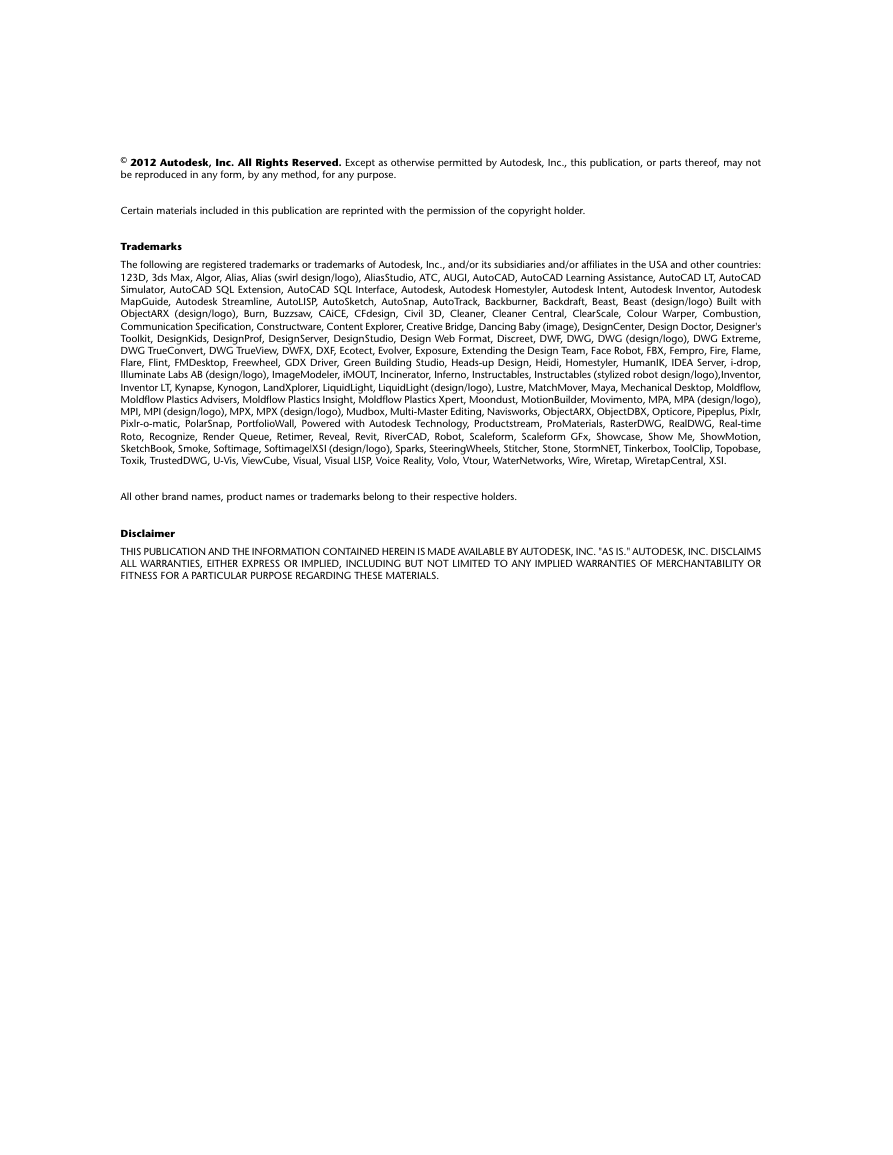
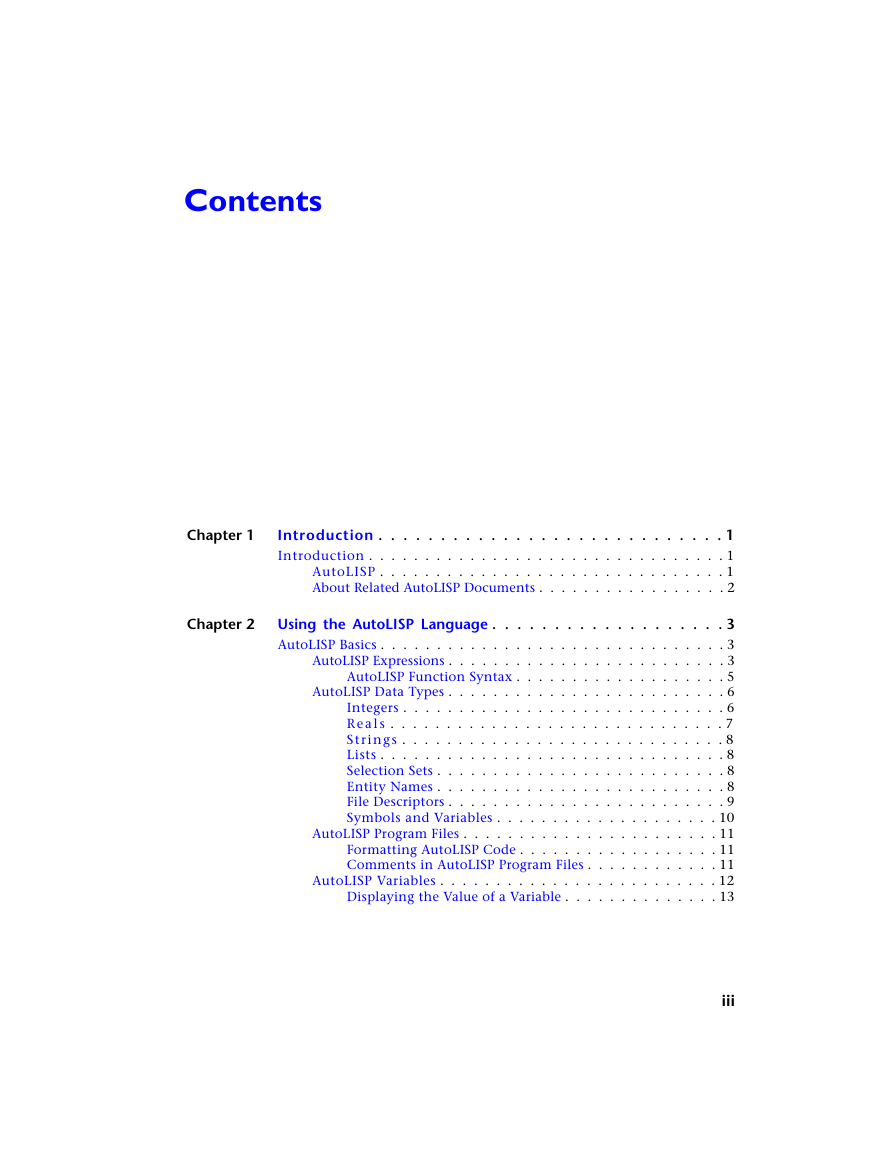
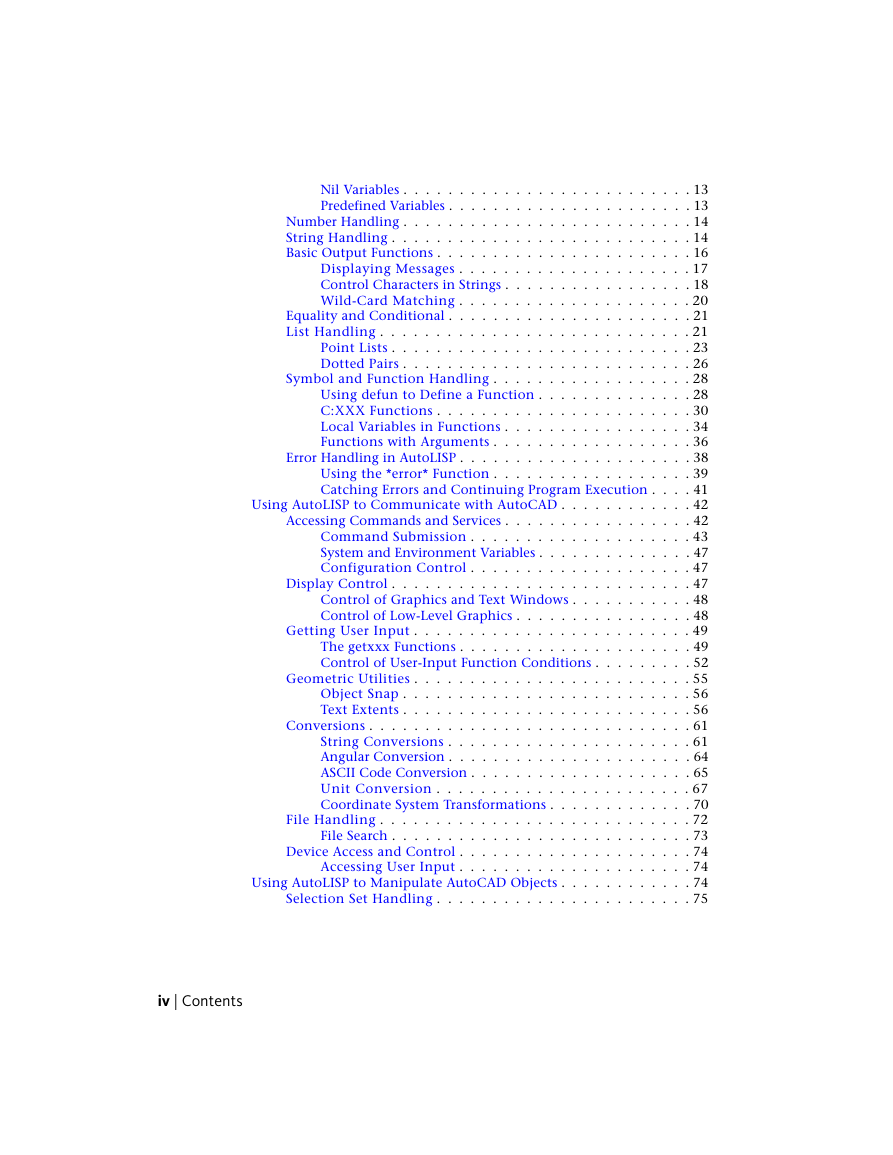
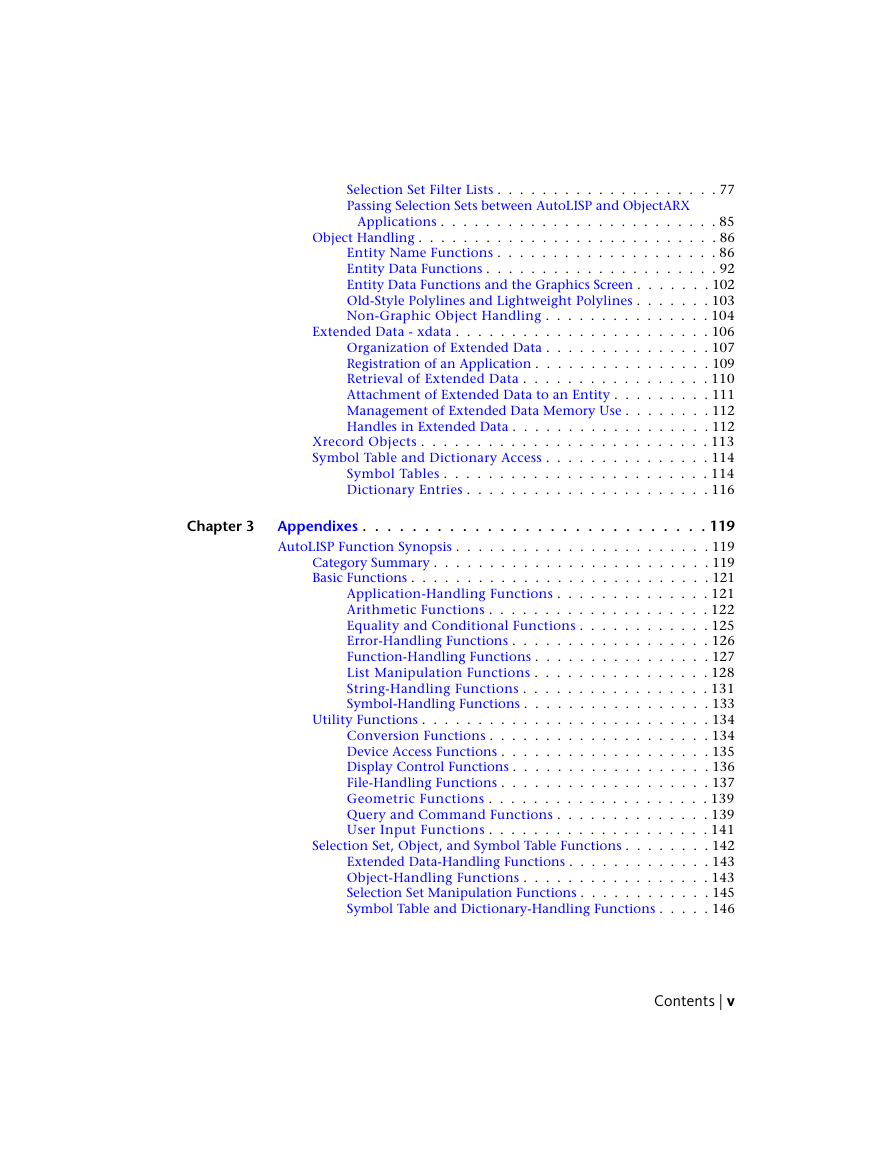
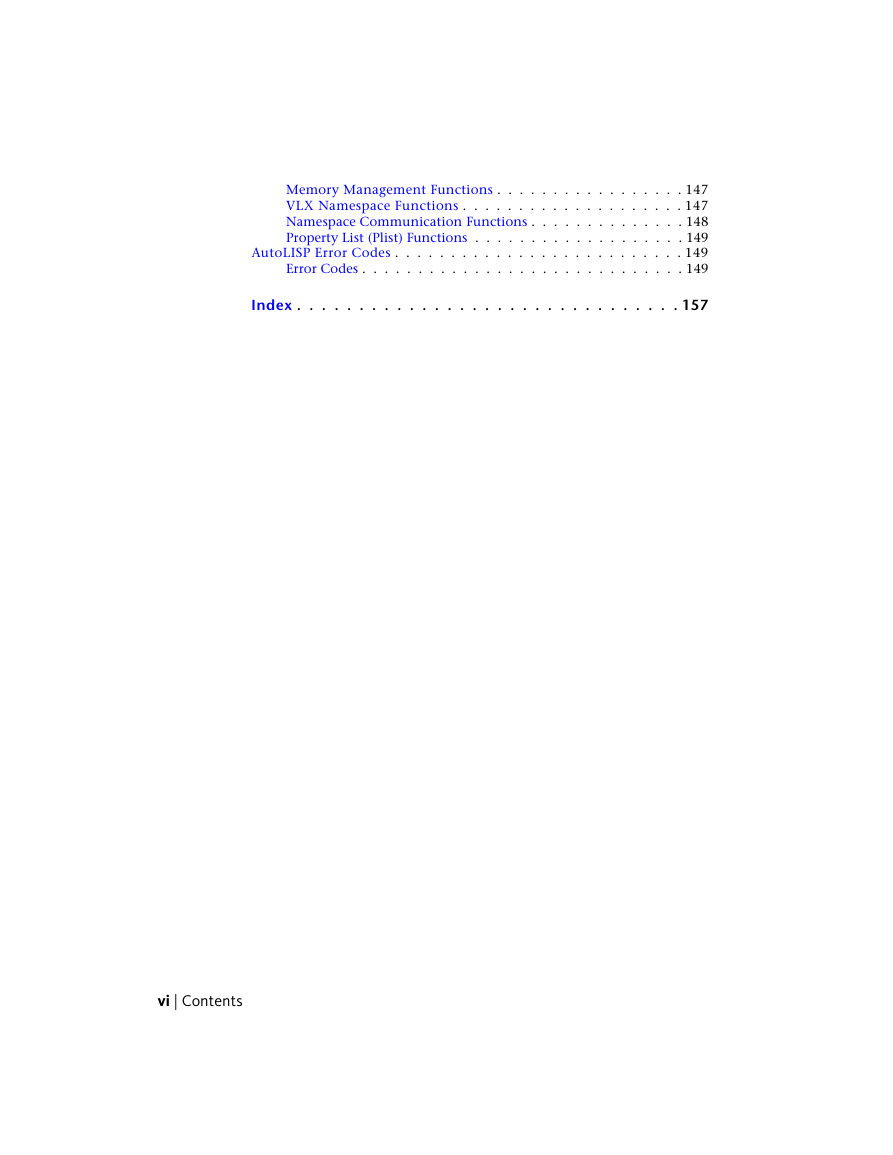
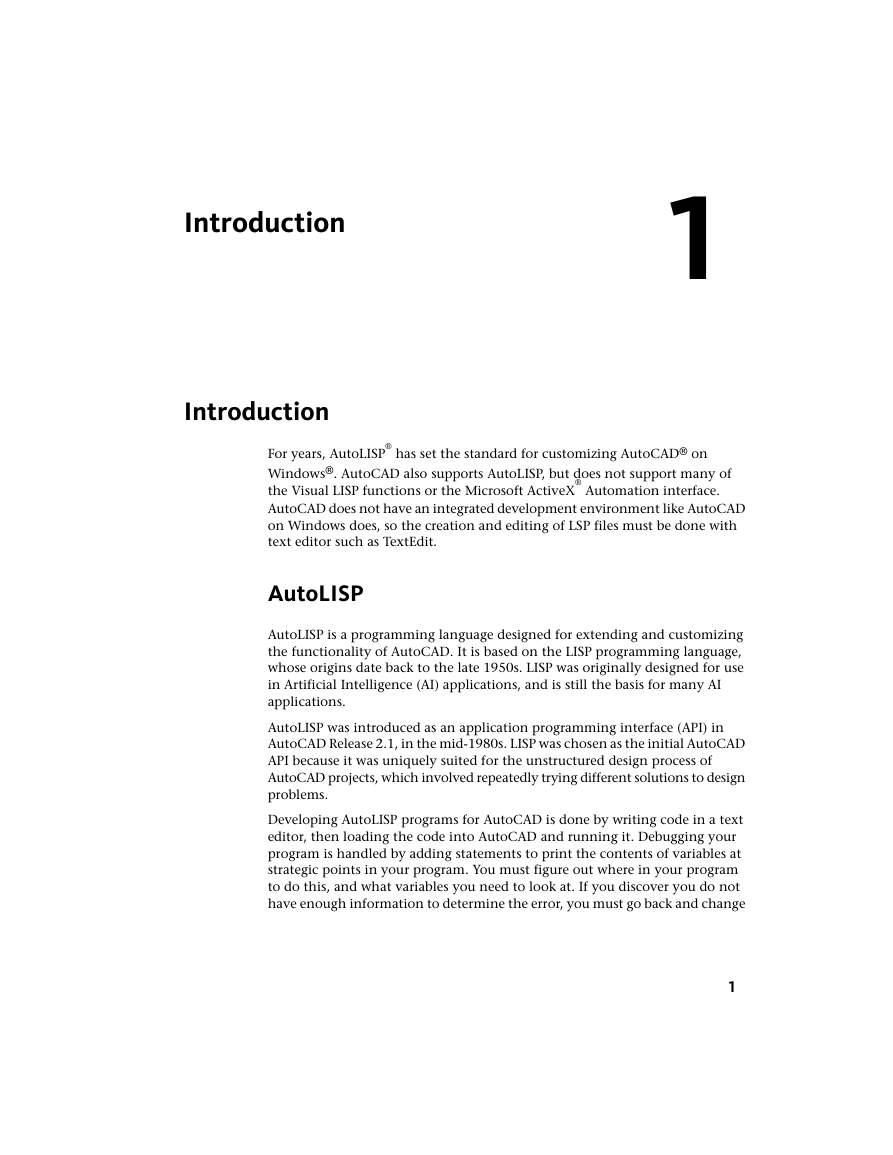
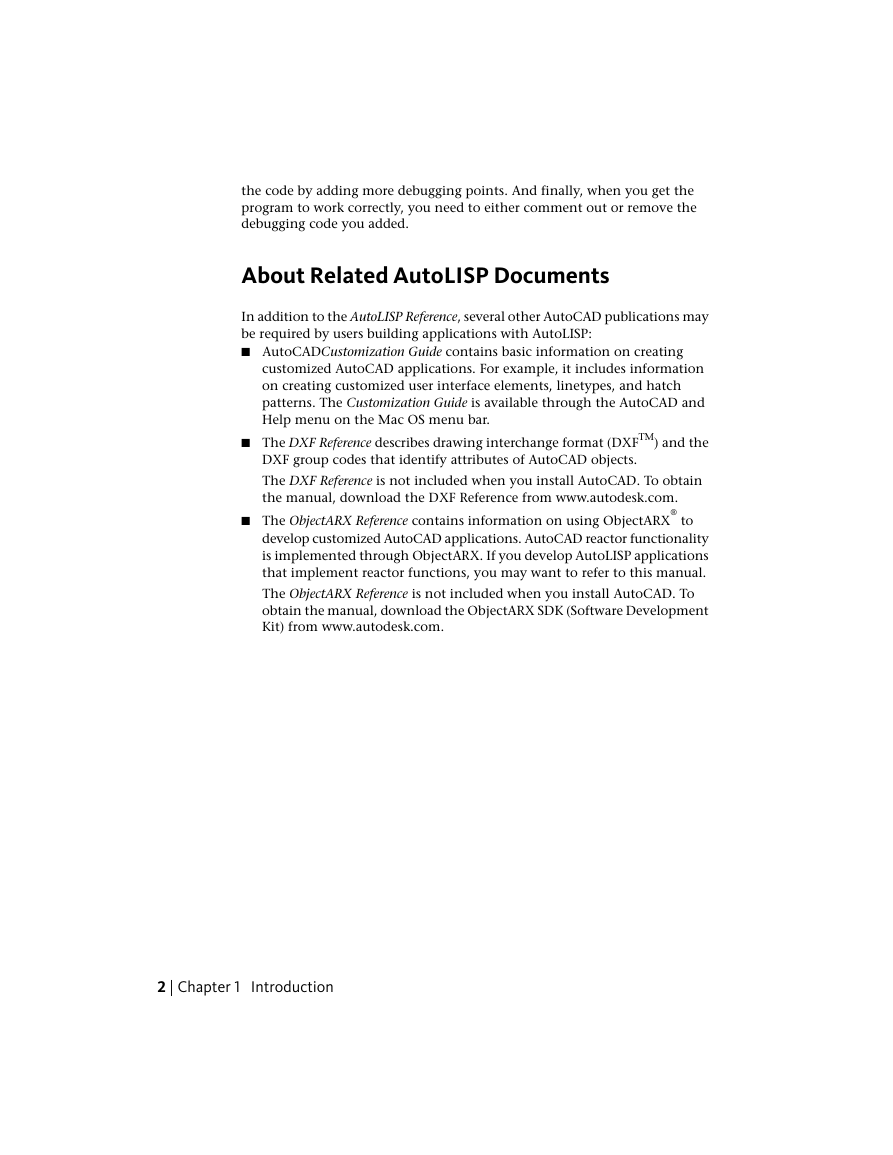








 2023年江西萍乡中考道德与法治真题及答案.doc
2023年江西萍乡中考道德与法治真题及答案.doc 2012年重庆南川中考生物真题及答案.doc
2012年重庆南川中考生物真题及答案.doc 2013年江西师范大学地理学综合及文艺理论基础考研真题.doc
2013年江西师范大学地理学综合及文艺理论基础考研真题.doc 2020年四川甘孜小升初语文真题及答案I卷.doc
2020年四川甘孜小升初语文真题及答案I卷.doc 2020年注册岩土工程师专业基础考试真题及答案.doc
2020年注册岩土工程师专业基础考试真题及答案.doc 2023-2024学年福建省厦门市九年级上学期数学月考试题及答案.doc
2023-2024学年福建省厦门市九年级上学期数学月考试题及答案.doc 2021-2022学年辽宁省沈阳市大东区九年级上学期语文期末试题及答案.doc
2021-2022学年辽宁省沈阳市大东区九年级上学期语文期末试题及答案.doc 2022-2023学年北京东城区初三第一学期物理期末试卷及答案.doc
2022-2023学年北京东城区初三第一学期物理期末试卷及答案.doc 2018上半年江西教师资格初中地理学科知识与教学能力真题及答案.doc
2018上半年江西教师资格初中地理学科知识与教学能力真题及答案.doc 2012年河北国家公务员申论考试真题及答案-省级.doc
2012年河北国家公务员申论考试真题及答案-省级.doc 2020-2021学年江苏省扬州市江都区邵樊片九年级上学期数学第一次质量检测试题及答案.doc
2020-2021学年江苏省扬州市江都区邵樊片九年级上学期数学第一次质量检测试题及答案.doc 2022下半年黑龙江教师资格证中学综合素质真题及答案.doc
2022下半年黑龙江教师资格证中学综合素质真题及答案.doc